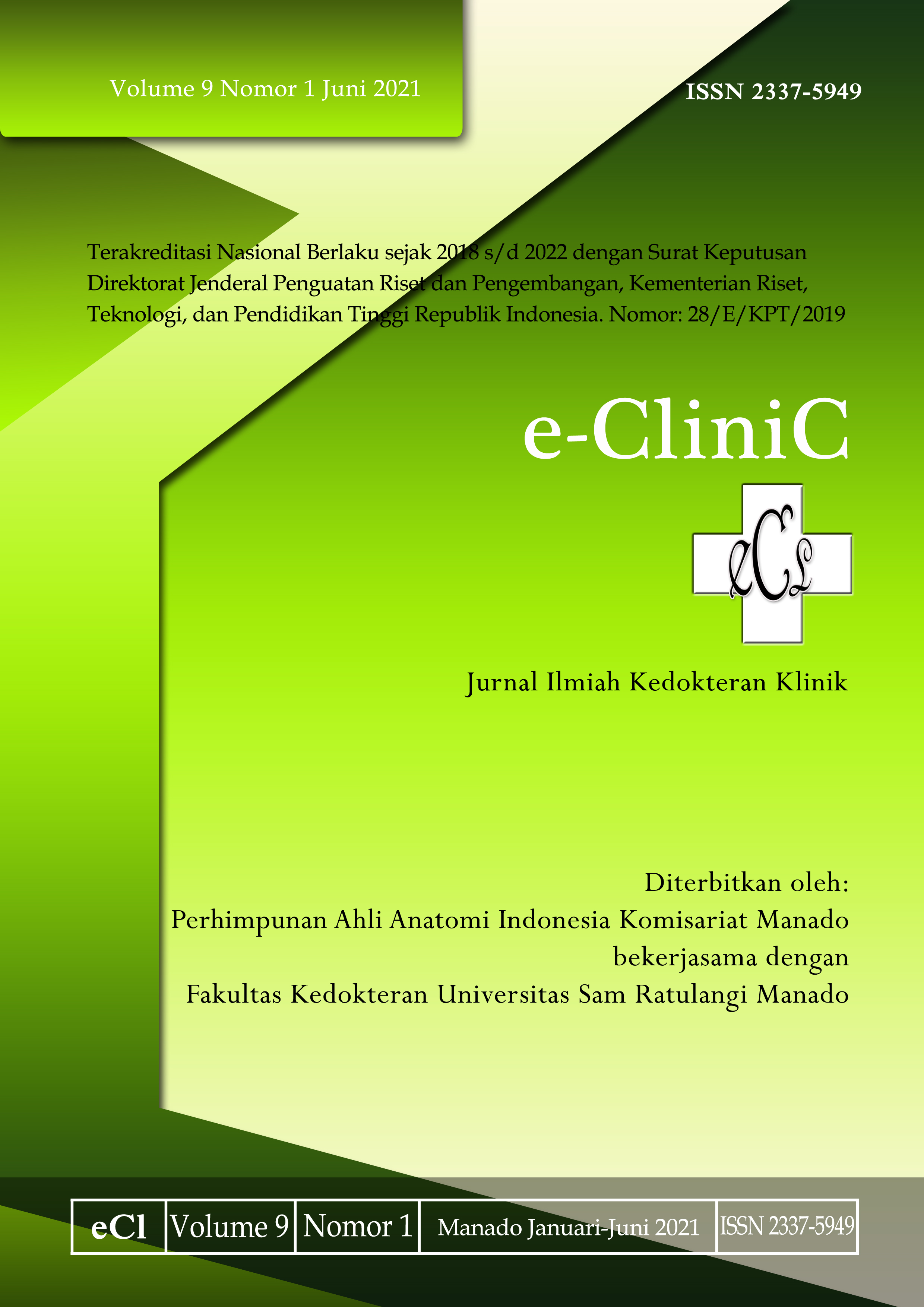Gambaran Health Belief Model pada Penanganan Fraktur
DOI:
https://doi.org/10.35790/ecl.v9i1.32364Abstract
Abstract: Alternative medicine or traditional medicine is still widely used as a treatment option, especially in dealing with fractures. A person's belief in curing a disease has a healing effect, albeit, it can also cause various complications in case of mishandling. This condition will affect health behavior related to health belief model. This study was aimed to obtain the health belief model in fracture treatment. This was a descriptive and observational study with a survey design. Data were obtained by using questionnaires. Subjects were all WKI GMIM Kalvari Parigi Tujuh as many as 230 females. The results showed that most subjects were >50 years old, had high school/vocational school education, and work as housewives. The majority of subjects chose to go to a masseuse as the initial action when they encountered fracture cases and admission to the hospital was in the third position, after the choice to consume over-the-counter drugs. Based on the health belief model, there were four aspects of perception, namely perceptions of seriousness, vulnerability, benefits, and barriers. Some of the subjects considered that: 1) fracture was not a serious disease; 2) fracture was not a threatening disease; 3) fracture treatment did not provide many benefits; and 4) there were many barriers in treating fractures. In conclusion, the public perception of fracture cases is good, but there is still room for improvement. Although the community prefers masseurs to get the initial treatment, the hospital remains a destination if the initial action is not successful.
Keywords: health belief model, fractures, fracture management, traditional medicine
Â
Abstrak: Pengobatan alternatif atau pengobatan tradisional masih banyak dipakai sebagai pilihan pengobatan terutama dalam menangani fraktur. Kepercayaan seseorang dalam kesembuhan sebuah penyakit tidak hanya membawa dampak penyembuhan, tetapi dapat menyebabkan berbagai komplikasi bila terjadi kesalahan penanganan. Kondisi sakit ini akan memengaruhi perilaku kesehatan sehubungan dengan health belief model. Jenis penelitian ialahj deskriptif observasional dengan desain survei. Pengambilan data menggunakan kuesioner. Subjek penelitian ialah seluruh WKI GMIM Kalvari Parigi Tujuh. Hasil penelitian mendapatkan 230 subjek penelitian, mayoritas berusia >50 tahun, memiliki tingkat pendidikan SMA/SMK, dan bekerja sebagai ibu rumah tangga. Mayoritas subjek penelitian memilih untuk pergi ke tukang pijat sebagai tindakan awal ketika menemui kasus fraktur dan rumah sakit menempati posisi ketiga, di bawah pilihan mengonsumsi obat warung. Berdasarkan health belief model, dilakukan pengukuran pada empat aspek persepi yaitu keseriusan, kerentanan, manfaat, serta hambatan. Didapatkan bahwa sebagian subjek menganggap bahwa: 1) fraktur bukan suatu penyakit yang serius; 2) fraktur bukan suatu penyakit yang mengancam; 3) penanganan fraktur tidak memberikan banyak manfaat; dan 4) banyak hambatan yang dihadapi untuk mengobati fraktur. Simpulan penelitian ini ialah persepsi masyarakat mengenai kasus fraktur sudah termasuk baik, tetapi masih terdapat ruang untuk peningkatan. Masyarakat lebih memilih tukang pijat untuk mendapatkan tindakan awal, namun rumah sakit tetap menjadi tujuan bila tindakan awal tidak berhasil.
Kata kunci: health belief model, patah tulang, penanganan fraktur, pengobatan tradisionalDownloads
How to Cite
Issue
Section
License
COPYRIGHT
Authors who publish with this journal agree to the following terms:
Authors hold their copyright and grant this journal the privilege of first publication, with the work simultaneously licensed under a Creative Commons Attribution License that permits others to impart the work with an acknowledgment of the work's origin and initial publication by this journal.
Authors can enter into separate or additional contractual arrangements for the non-exclusive distribution of the journal's published version of the work (for example, post it to an institutional repository or publish it in a book), with an acknowledgment of its underlying publication in this journal.
Authors are permitted and encouraged to post their work online (for example, in institutional repositories or on their website) as it can lead to productive exchanges, as well as earlier and greater citation of the published work (See The Effect of Open Access).







